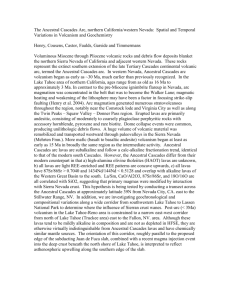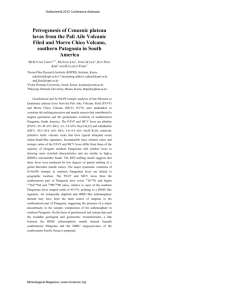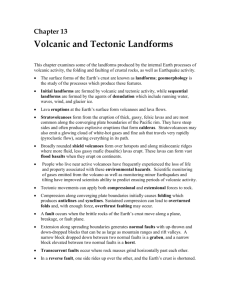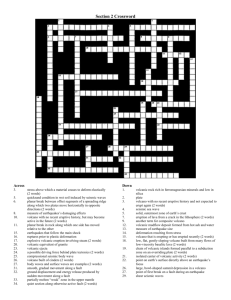In-Depth examination of an Island Arc Volcano
advertisement
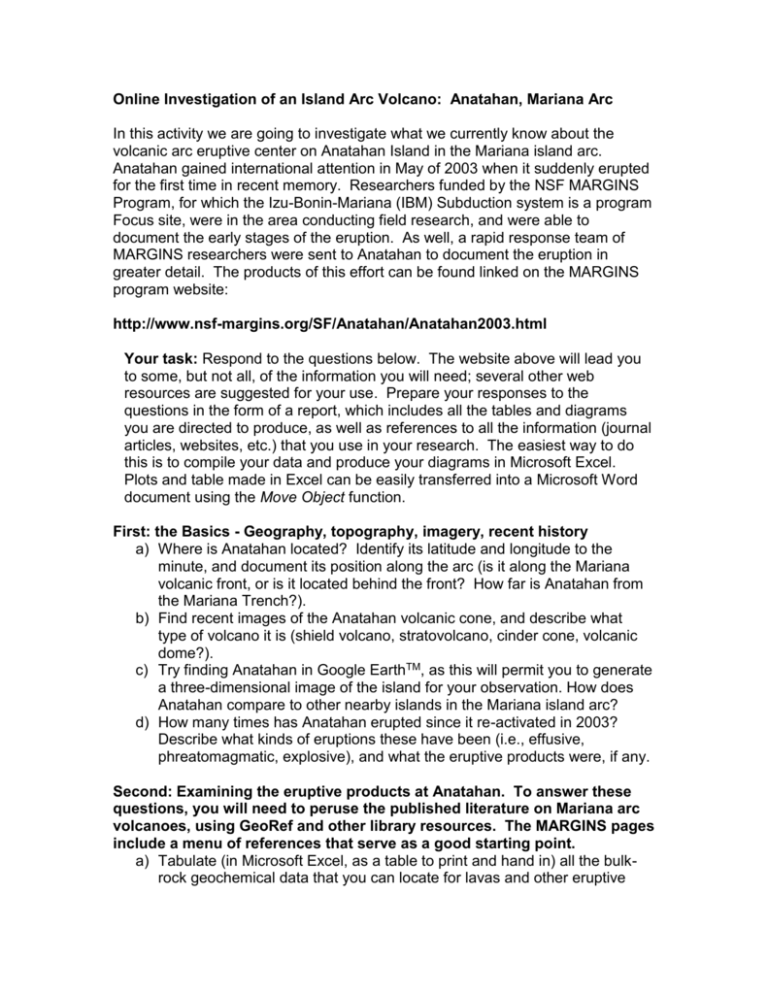
Online Investigation of an Island Arc Volcano: Anatahan, Mariana Arc In this activity we are going to investigate what we currently know about the volcanic arc eruptive center on Anatahan Island in the Mariana island arc. Anatahan gained international attention in May of 2003 when it suddenly erupted for the first time in recent memory. Researchers funded by the NSF MARGINS Program, for which the Izu-Bonin-Mariana (IBM) Subduction system is a program Focus site, were in the area conducting field research, and were able to document the early stages of the eruption. As well, a rapid response team of MARGINS researchers were sent to Anatahan to document the eruption in greater detail. The products of this effort can be found linked on the MARGINS program website: http://www.nsf-margins.org/SF/Anatahan/Anatahan2003.html Your task: Respond to the questions below. The website above will lead you to some, but not all, of the information you will need; several other web resources are suggested for your use. Prepare your responses to the questions in the form of a report, which includes all the tables and diagrams you are directed to produce, as well as references to all the information (journal articles, websites, etc.) that you use in your research. The easiest way to do this is to compile your data and produce your diagrams in Microsoft Excel. Plots and table made in Excel can be easily transferred into a Microsoft Word document using the Move Object function. First: the Basics - Geography, topography, imagery, recent history a) Where is Anatahan located? Identify its latitude and longitude to the minute, and document its position along the arc (is it along the Mariana volcanic front, or is it located behind the front? How far is Anatahan from the Mariana Trench?). b) Find recent images of the Anatahan volcanic cone, and describe what type of volcano it is (shield volcano, stratovolcano, cinder cone, volcanic dome?). c) Try finding Anatahan in Google EarthTM, as this will permit you to generate a three-dimensional image of the island for your observation. How does Anatahan compare to other nearby islands in the Mariana island arc? d) How many times has Anatahan erupted since it re-activated in 2003? Describe what kinds of eruptions these have been (i.e., effusive, phreatomagmatic, explosive), and what the eruptive products were, if any. Second: Examining the eruptive products at Anatahan. To answer these questions, you will need to peruse the published literature on Mariana arc volcanoes, using GeoRef and other library resources. The MARGINS pages include a menu of references that serve as a good starting point. a) Tabulate (in Microsoft Excel, as a table to print and hand in) all the bulkrock geochemical data that you can locate for lavas and other eruptive products from Anatahan. Be sure that the data you include IS bulk-rock chemical data, and not mineral analysis data, such as one obtains from an electron microprobe. Include both major element data, and data for all the trace elements you can find for each sample (note: the trace element data for any given sample or sample set may be found in different tables in the same paper, or even in different papers). Along with the data for each sample, make note of the analytical method(s) used to make the measurements, as this information is necessary to assessing data reliability. b) Compile all thin section imagery and descriptive captions that you can for Anatahan lavas (this may be tougher!), as well as petrographic descriptions from the texts of the papers that you have found. What are the primary phenocryst phases reported for Anatahan lavas? How phyric are these lavas (i.e, what are their percentages of phenocrysts)? c) Plot your compiled Anatahan data on Total Alkalies vs. Silica (TAS) rock classification diagram. What kinds of volcanic rocks has Anatahan erupted, based on this plot? d) Using an "igneous" AFM diagram (triangular plot of MgO vs. Fe203 vs. Na2O+K2O), ascertain whether Anatahan lavas follow a Tholeiitic or CalcAlkaline differentiation trend. How do the reported phenocryst assemblages in Anatahan lavas relate to your inferences from this diagram? Third: Comparing Anatahan geochemically to other Mariana Arc volcanic lavas. To do this you will need to compile a major and trace element dataset for young (Pleistocene to Recent) Mariana arc lavas in Excel. Distinguish these lavas by volcano (i.e., create different worksheet pages or segments within a worksheet for lavas from each volcano you include). a) Look at your compiled Mariana and Anatahan data on a series of Harker Diagrams (i.e., plots of different elemental abundances vs. SiO 2 content). Examine MgO, TiO2, and K2O, along with the trace elements Ba, Sr, V, Ni, Cr and Zr (if you don't have these particular trace elements, feel free to substitute from those you did find). How does each of these elements vary with changing silica content? b) Go to the Geochemical Earth Reference Model (GERM) website and obtain Mineral/melt Partition Coefficient data for the trace elements that you plotted in a), for the minerals olivine, plagiclase feldspar, and clinopyroxene (Note that the GERM site may have multiple values for a particular mineral/melt system - if so, take the mean of the values reported.). A Bulk solid/melt Distribution coefficient can be calculated for a progressively crystallizing magmatic system by calculating the weighted sum of the relevant mineral-melt partition coefficients, i.e.: DS/L = Dol/l* Xol + Dplag/l*Xplag+Dcpx/l*Xcpx, etc., X=1 Using the phenocryst proportions you discovered for the Anatahan lavas, calculate bulk solid/melt distribution coefficients for the trace elements you plotted in a) above, as well as for TiO2 and for K2O (look for Ti and K partition coefficients in the GERM site). Identify the two elements with the lowest solid/melt distribution coefficients, and the elements with the highest mineral/melt partition coefficients for olivine, plagioclase, and clinopyroxene, respectively. c) Comparing elements with very small DS/L values to those with large mineral/melt partitioning values for a particular mineral can help one identify the geochemical impact of the crystallization of that mineral on an evolving magma. Plot the abundances of the element with the smallest DS/L value versus the element with the highest Dplag/l value. What does the variation pattern look like on this diagram? Do all the volcanes show similar trends, or are there variations? d) Comparing elements with very small DS/L values minimizes the effects of crystallization, and allows one to see variations related to chemical differences among the source rocks for the magmas. Plot the abundances of the two elements you found to have the smallest DS/L values. How do the different volcanoes in the Mariana arc compare? Is Anatahan similar or different relative to other Mariana volcanoes?


